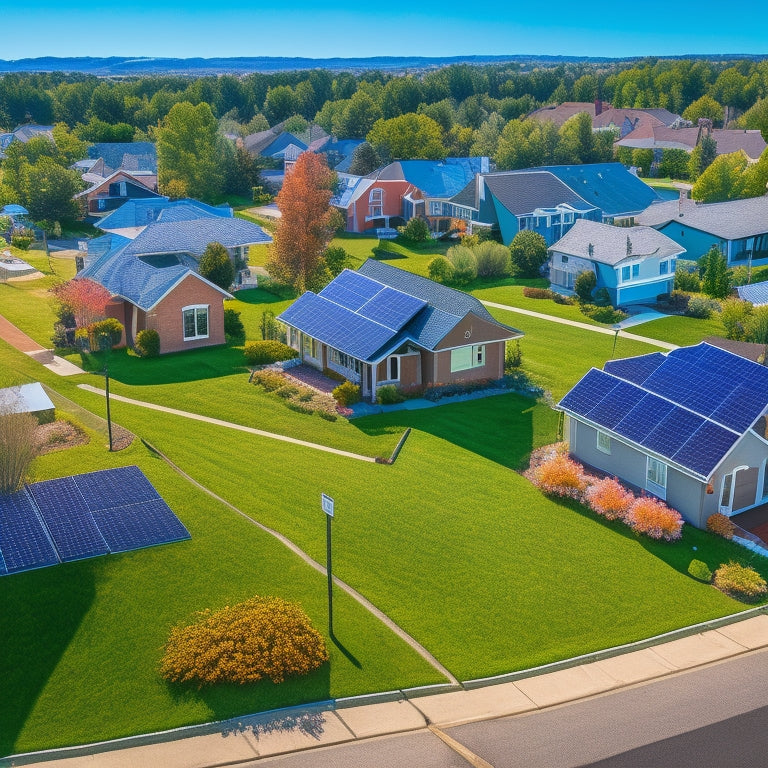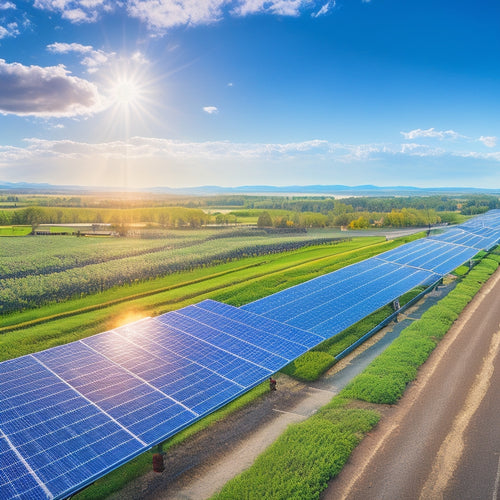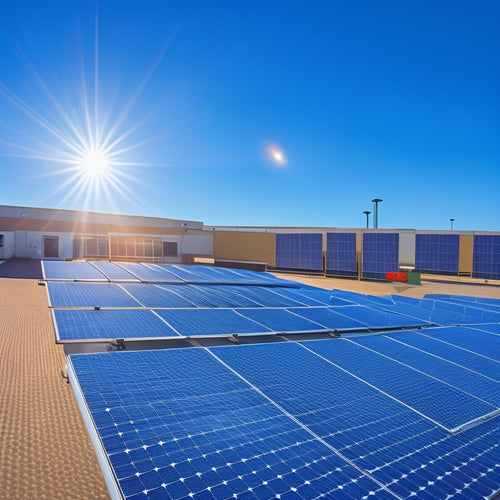
Solar Panel Installation Price
Share
You can expect to pay between $15,000 and $30,000 for a typical solar panel installation, although the actual cost will depend on various factors, including the system size, panel efficiency, and local incentives. Government incentives, like the Federal Tax Credit, can reduce your upfront costs, contributing to a faster return on investment. Additionally, high-efficiency panels and advanced technologies like Maximum Power Point Tracking can optimize your energy output and savings. With so many variables at play, understanding the complexities of solar installation pricing is vital - and there's more to investigate to get the most out of your investment.
The Essentials
- The Solar Investment Tax Credit (ITC) offers a 26% tax credit on the total solar system cost, directly reducing tax liability and enhancing savings.
- State rebate programs provide financial assistance to offset upfront installation costs, with varying funding options and eligibility criteria by state and program.
- High-efficiency solar panels generate more power per unit area, reducing reliance on the grid and saving space and installation costs.
- The cost of solar panel installation varies depending on system size, installation company, and local incentives, with an average cost range of $2.50 to $3.50 per watt.
- Maximum Power Point Tracking (MPPT) technology maximizes solar panel output under varying conditions, adjusting to changes in temperature and irradiance for peak performance.
Government Incentives Available Now
You're likely aware that the cost of solar panel installation can be considerable, but you may not know that you can offset some of that expense with government incentives.
By investing in solar power and battery storage solutions, you can't only reduce your electricity bills but also contribute to a healthier environment for future generations.
Currently, you're eligible for federal tax credits that can reduce your tax liability, and you may also qualify for state rebate programs that provide cash back or other benefits.
Federal Tax Credits
Take advantage of the federal government's incentives to offset the cost of your solar panel installation. As a homeowner, you're eligible for federal tax credits that can greatly reduce your solar investment.
By installing rooftop solar panels, you can elevate your home's energy efficiency and contribute to a cleaner, healthier environment. The Solar Investment Tax Credit (ITC) allows you to claim a tax credit of 26% of the total cost of your solar panel system. This means you can subtract 26% of your total expenditure from your federal taxes, providing considerable tax credit benefits.
To qualify, your solar panel system must be installed and operational by December 31st of the tax year. You'll need to file IRS Form 5695 with your tax return to claim the credit.
The ITC is a dollar-for-dollar reduction in your tax liability, making it an important incentive for homeowners investing in solar energy. By taking advantage of this federal tax credit, you can maximize your savings and enjoy a faster return on your solar investment.
State Rebate Programs
Several states offer additional incentives for homeowners investing in solar energy. These state rebate programs can provide significant financial assistance to help offset the upfront cost of solar panel installation. You may be eligible for installation discounts, energy savings, and other benefits that can make going solar more affordable.
| State | Rebate Amount | Eligibility Criteria |
|---|---|---|
| California | Up to $1.25/W | Residential and commercial properties with systems up to 1 MW |
| New York | Up to $1.00/W | Residential and commercial properties with systems up to 200 kW |
| Massachusetts | Up to $1.20/W | Residential and commercial properties with systems up to 1 MW |
When exploring state rebate programs, you'll want to research the specific funding options, application processes, and eligibility criteria for your area. Some programs may have specific requirements, such as system size or installation deadlines, so be sure to review the details carefully. Additionally, many local programs and community initiatives offer additional solar incentives, so it's worth investigating these opportunities as well. By taking advantage of these state rebate programs, you can maximize your savings and make the shift to solar energy even more rewarding.
Zero Carbon Footprint
You're likely considering solar panel installation to reduce your reliance on fossil fuels and shift to a more eco-friendly lifestyle.
With residential solar power systems, you can generate renewable energy and save on electricity bills with efficient and durable house solar panels renewable energy systems.
By utilizing renewable energy sources like solar power, you can greatly minimize your carbon footprint.
With the right solar panel installation, you can enjoy a reduced energy bill and a clear conscience, knowing you're contributing to a cleaner environment.
Renewable Energy Sources
Renewable energy sources have become an important component in the quest for a zero-carbon footprint, and it's no wonder why. As you aim for energy independence, you're likely considering sustainable practices that reduce your reliance on fossil fuels.
Renewable energy sources, such as solar, wind, and hydro power, offer a cleaner alternative to traditional energy generation methods. By utilizing these natural resources, you can greatly decrease your carbon footprint and contribute to a cleaner environment.
Solar panels, in particular, have become increasingly popular due to their efficiency and cost-effectiveness. With the ability to generate electricity on-site, you can reduce your energy bills and enjoy a sense of independence from the grid.
When it comes to renewable energy sources, the benefits extend beyond environmental advantages. You'll also experience increased energy security, reduced maintenance costs, and a potential increase in your property value.
As you examine your options for a zero-carbon footprint, renewable energy sources should be at the top of your list. By investing in these sustainable practices, you'll be taking an important step towards a cleaner, more energy-independent future.
Eco-Friendly Living Options
As you consider your options for achieving a zero-carbon footprint, eco-friendly living options become an essential aspect of your overall strategy.
You'll want to focus on sustainable materials and practices that reduce your impact on the environment. This means opting for energy-efficient appliances, insulating your home, and using renewable energy sources like solar power.
Adopting an eco-conscious lifestyle requires a comprehensive approach.
You'll need to assess your daily habits and make conscious choices to reduce your carbon footprint. This might involve reducing your water usage, recycling, and composting.
You can also make a significant impact by choosing sustainable materials for your home, such as bamboo flooring, low-VOC paints, and recycled glass countertops.
Maximum Power Point Tracking
You're likely aware that maximum power point tracking (MPPT) is essential for efficient energy harvesting in your solar panel installation.
MPPT guarantees that your system operates at its best performance by continuously monitoring and adjusting to changes in temperature, irradiance, and other environmental factors.
This is especially important when considering home battery storage to enhance your energy yield.
Efficient Energy Harvesting
Maximum power point tracking (MPPT) is an essential component of efficient energy harvesting in solar panel systems, ensuring that your panels produce the maximum possible power output under varying environmental conditions. This innovative technology is a key driver of energy innovation in the solar industry.
By continuously monitoring and adjusting the operating voltage of your solar panels, MPPT optimizes energy production, even in situations with partial shading or fluctuating temperatures.
As you investigate the possibilities of solar technology, you'll find that MPPT is a critical factor in maximizing your return on investment. By capturing the maximum amount of energy from the sun, you'll reduce your reliance on traditional energy sources and enjoy greater freedom from utility bills.
With MPPT, you can rest assured that your solar panel system is working at peak efficiency, generating clean energy and reducing your carbon footprint. By utilizing the full potential of your solar panels, you'll be well on your way to achieving energy independence and a more sustainable future.
Optimized Performance Control
Optimized Performance Control, also known as Maximum Power Point Tracking (MPPT), is the brain behind your solar panel system's ability to adapt to changing environmental conditions. This advanced technology guarantees you get the most out of your solar panels by continuously monitoring and adjusting the system's performance to maximize energy production.
MPPT is essential in solar technology as it allows your system to respond to variations in temperature, irradiance, and other environmental factors that impact energy output. By optimizing performance, you can enjoy increased energy independence and reduced reliance on the grid.
Here is a comparison of MPPT and traditional PWM (Pulse Width Modulation) controllers:
| Characteristics | MPPT | PWM |
|---|---|---|
| Efficiency | Up to 99% | Up to 95% |
| Performance Optimization | Continuous monitoring and adjustment | Fixed voltage and current |
| Energy Harvesting | Maximizes energy production | Limited energy production |
| Compatibility | Suitable for most solar panels | Limited to specific panel types |
| Cost | Generally more expensive | Generally less expensive |
Efficiency Ratings Matter Most
When you're evaluating solar panel installation prices, you'll want to take into account the efficiency ratings of different panels. Higher efficiency means more power per unit area, which can be a key factor in your overall energy output.
As you investigate residential solar panel systems, reflect on the role of Photovoltaic cells in converting sunlight into electricity, and how this impacts panel efficiency.
Higher Efficiency Equals More
How much electricity can you expect to generate from your solar panel installation? The answer largely depends on the efficiency of your solar panels. Higher-efficiency panels can convert more sunlight into electrical energy, resulting in greater electricity generation.
Here's a comparison of three different solar panel efficiency ratings:
| Efficiency Rating | Electricity Generation (kWh/year) |
|---|---|
| 15% | 4,500 |
| 18% | 5,400 |
| 20% | 6,000 |
As you can see, even a small increase in efficiency rating can considerably enhance electricity generation. This is because higher-efficiency panels can utilize more energy from the same amount of sunlight. By investing in high-efficiency solar panels, you can optimize your energy conversion and reduce your reliance on the grid.
When it comes to solar technology, energy conversion is key. By choosing panels with higher efficiency ratings, you can access more power and freedom from the grid. Remember, higher efficiency equals more electricity generated, which translates to greater savings and energy independence.
Panel Efficiency Comparison
What sets high-efficiency solar panels apart from their lower-efficiency counterparts? The answer lies in the panel materials and solar technology used. High-efficiency panels boast advanced materials that maximize energy conversion, resulting in more power per hour of sunlight. This means you'll generate more electricity with fewer panels, saving you space and installation costs.
When comparing panel efficiencies, you should consider the performance metrics that matter most to you. Do you prioritize energy storage and environmental impact, or cost analysis and warranty options? Regardless, high-efficiency panels offer superior performance, with some models reaching efficiencies of over 22%. In contrast, lower-efficiency panels may struggle to reach 15%.
As you weigh your options, keep in mind that market trends are shifting towards higher-efficiency panels. Installation techniques are also progressing to accommodate these advanced panels, ensuring maximum performance and longevity.
Higher Energy Density Cells
You're likely aware that higher energy density cells are an essential factor in maximizing your solar panel installation's energy output.
These advanced cells enable you to generate more power per unit area, which can greatly enhance your overall energy production.
Increased Energy Output
Higher energy density cells are revolutionizing solar panel installation by maximizing energy output per unit area. You're likely to benefit from this technology if you're considering solar panels for your home or business. With higher energy density cells, you can generate more power from a smaller surface area, making them ideal for urban spaces or areas with limited roof size.
| Cell Type | Energy Output (W/m²) |
|---|---|
| Traditional | 150-200 |
| High-Efficiency | 250-300 |
| Bifacial | 300-350 |
| Perovskite | 350-400 |
| Multi-Junction | 400-450 |
These advanced cells not only increase energy output but also reduce the overall cost of solar panel installation. As solar technology continues to advance, it's becoming more feasible to integrate energy storage solutions, allowing you to capture and store excess energy for later use. By upgrading to higher energy density cells, you'll be able to power your home or business more efficiently, reducing your reliance on the grid and increasing your energy independence.
Frequently Asked Questions
Can I Install Solar Panels on a Rented Property?
You'll need to review your tenant agreements and obtain installation permissions from your landlord before putting up solar panels on a rented property, ensuring you're not violating any terms and maintaining a harmonious landlord-tenant relationship.
How Do I Know if My Roof Is Suitable for Solar Panels?
Don't worry, you won't need to own your home to go solar! To determine if your roof is suitable, you'll need to assess its orientation and conduct a shading analysis to guarantee ideal energy production - an essential step towards energy independence!
Can I Sell Excess Energy Back to the Grid?
You can sell excess energy back to the grid through net metering benefits, which allow you to offset your energy consumption and even receive credits or cash through energy buyback programs, giving you more control over your energy independence.
Are Solar Panels Resistant to Extreme Weather Conditions?
Like Odysseus braving the fury of Poseidon, you'll find solar panels standing strong against extreme weather conditions; their durability and resilience guarantee they'll utilize the sun's power, unyielding to torrential rains or scorching heat, giving you the freedom to generate clean energy.
Do Solar Panels Require Regular Maintenance?
You'll find that solar panels require minimal maintenance, with a typical maintenance frequency of every 6-12 months, ensuring a prolonged solar panel lifespan of 25-30 years, allowing you to enjoy unhindered freedom from energy dependence.
Final Thoughts
As you weigh the costs and benefits of solar panel installation, remember that the initial investment is merely a stepping stone to a brighter, more sustainable future. By utilizing the power of the sun, you'll not only reduce your reliance on fossil fuels but also reap the rewards of significant long-term savings. With government incentives, advanced technology, and improved efficiency, the price of solar panel installation is a small price to pay for a guilt-free conscience and a healthier planet.
Related Posts
-

Top 10 Off Grid Camping Gear Must-Haves
When you're off-grid camping, the right gear is crucial for a smooth expedition. Start with a durable, weather-resist...
-

Applications of Photovoltaic Systems
Photovoltaic systems are versatile, converting sunlight into electricity for various applications. You can use them i...
-

Essential Solar Panel Mounts for Commercial Properties
When it comes to essential solar panel mounts for your commercial property, durability and wind resistance are key fa...


